Juliet Rufford
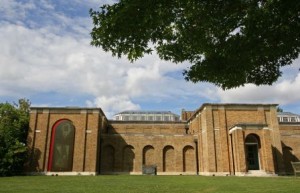
A curious episode in the history of art involves King Stanislaw Augustus Poniatowski, who commissioned two London dealers, Noël Desenfans and Francis Bourgeois, to buy paintings to start a Polish national collection. That was in 1790. By 1795, Poland had been partitioned by Catherine the Great of Russia, a former lover of Stanislaw’s, and the king had been forced to abdicate. The pictures remained in the hands of the dealers until the death of the younger man, Bourgeois, in 1811, when they were bequeathed to Dulwich College “for the inspection of the public.” Bourgeois also stipulated that the distinguished architect Sir John Soane should design a purpose-built space in which the paintings could be viewed. Soane accepted the challenge, commencing works the day after Bourgeois’ death, and the building, Dulwich Picture Gallery, was opened in 1817. Over the past two centuries, the gallery’s series of sky-lit rooms has influenced the design of exhibition spaces across the world. But it was the story of King Stanislaw that provided the initial inspiration for a project called The Polish Connection, in which four state portraits of the monarch (on loan from Warsaw) would sit alongside a major intervention by the Polish artist Antoni Malinowski.
Since moving to London in 1979, Malinowski has worked on canvases, large public art-works and site-specific projects. Best known for his Vermilion Wall at the Royal Court theatre, in Sloane Square, Malinowski’s work at Dulwich Picture Gallery was an investigation into the Warsaw connection that gave rise to England’s first public art gallery. Working across national borders, unbuilding the distinction between architectural and pictorial space, and orchestrating a series of performance events that responded to the artworks, Malinowski structured the exhibition in two parts (the first taking place in Dulwich from 16 June to 27 September, 2009; the second, at Warsaw’s Royal Castle in September, 2009). At Dulwich, an external painting filled the blind niche on the left side of the gallery’s façade and, on the other side of this wall, a linear drawing interacted with portraits by Marcello Bacciarelli and John Baptist von Lampi, the Elder, which Malinowski had hung on a background of Prussian blue.
We talked about his work in June.
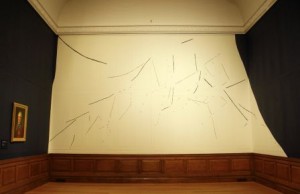
JR: Could you explain how the works at Dulwich Picture Gallery came about?
AM: In many ways, this project is a continuation of a collaboration between myself and the Korean choreographer-dancer Yong Min Cho. We developed this method of working five years ago, in Venice, for an installation event called ‘Bridging Lines.’ The idea, which was drawn from Venetian myth, was to see if we could ‘bridge’ the two banks of the Giudecca Canal. I made linear wall drawings in buildings situated on either side of the water and, in extending these rhythmic drawings into a dance performance that took its audience, by boat, from one side of the canal to the other, we proposed a different reading of the urban space. A variation on this art and performance work was shown in Milan the following year. My installations for The Polish Connection play with this idea of bridging. In addition, what appealed to me about the idea to start a collection was King Stanislaw’s wish to progress understandings of art and culture amongst his people. At the time, this would have been an eccentric and barely realisable idea. But, this gesture from two hundred years ago has proved stronger than the mighty empires that battled over Poland. My primary task was to communicate the enduring significance of ephemeral gestures.
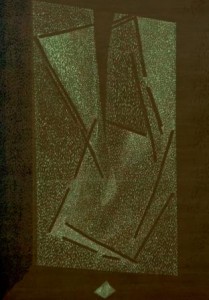
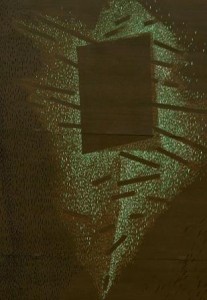
JR: Your work at Dulwich is best understood as site-specific although there are several sites to which it might be said to be responding; these are both geographical and discursive. How would you describe your approach to site-specific work? And, what are the defining characteristics of the Dulwich project?
AM: I always aim to create a certain tension between my work and its context although I do not tackle the ‘problem’ of site head-on but, instead, look for more harmonious solutions. Typically, these include infiltration and reflection. It is true that there are shades of other places and events here: Warsaw is an absent presence, and, to the extent that The Polish Connection continues my experiments in Italy, there are other sites still that haunt this one. Nonetheless, this project is absolutely site-specific. I have spent a lot of time over the past year conducting research on-site. I carried out many observations, noting the existing site conditions and the quality of light. For instance, the band of opaque vermilion that frames the left-hand side of the niche painting emphasises the harsh shadow cast by the sun on a bright day. I wanted to relate my work here to the eighteenth century portraits that we brought over from Warsaw’s Royal Castle and National Museum, to the paintings in the gallery’s permanent collection, and to Soane’s architecture. In fact, I have allowed my art to be determined by that architecture. Soane’s original plans for the gallery suggest that the niche on the east façade would have been an opening. Instead, I was faced with a wall. I started to look for ways to dematerialise that wall because, for me, art that dissolves into architecture and architecture that dissolves into art can produce a new mental space. My interventions optically open the wall. On the outside, this spatial twisting is achieved through the painterly manipulation of space; inside, through graphic means. The wall now dismantles the idea of a barrier and embraces its surroundings.
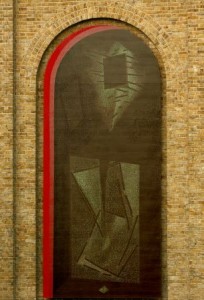
JR: This seriously troubles the conventional association of architecture with fixity, which has held currency in Western architectural discourse for so long! It also relates meaningfully to the spatial theory of Anthony Vidler. In Warped Space, Vidler argues that artists who have taken on questions of architecture and architects who have taken on questions of art have changed the way in which a genre- and practice-based space might be read (2000: 10). Would that be a fair assessment of what you are doing?
AM:Yes, that is an interesting way of looking at it. Moreover, it ties in with the question of what it means to paint today. In the digital age in which we live, and in which we are constantly invaded by images, what can painting offer? By painting with light-reflective, diachromatic pigments, which are unstable and mutable, and by positioning my work outside the gallery, where it becomes part of the natural landscape and the architecture of the building, I am entering into a dialogue with the history of painting, going back to pre-easel painting, when paintings were far more closely connected to their architectural settings. Since the nineteenth century, the boundary lines between the arts have become quite strictly drawn. Previously, art and architecture enjoyed a more productive relationship: frescos and altar paintings, for example, were very much part of their architectural contexts. In revisiting particular physical forms like the arch, which is composed out of a circle and a square, I am working with a shape that the history of art (especially sacred art) has loaded with meanings. The challenge is to find a means of negotiating between the theological and the compositional aspects, the art historical and the geometric or architectural, and to do so in an unashamedly contemporary way!
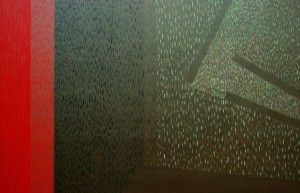
JR: Besides the part-framing of the niche painting with that magisterial red, the composition of the work contains various dark shapes and patterns of iridescent colour. Inside the gallery, the linear wall drawing has been given a light touch. In some places, the lines are quite faint; in others, they appear to have been broken up to produce a series of dashes, the mere adumbration of a line. How and why did you settle on the forms that you have used?
AM:I want to take issue with the idea that paintings have to be rectangular and hung on walls. The rectangle is a dominant shape in our civilisation and it can be seen not only in the shape of artists’ canvases (which are usually framed and set aside as ‘valuable’) but in windows, television and computer screens, and so on. That is one reason for painting murals and for working with irregular spaces. In Poland, endless wars have obliterated many works of art. The crushed rectangles that you see in the niche painting are a reference to the destruction of so much art. And yet, my work is not about destruction but about the possibility that out of fragmentation and partition something else might emerge. Physically, the lines are sculpting (an) absence. What do I mean by this? Well, on one level, they are sculpting the absence of the parts of the present exhibition from their Warsaw home; on another level, they are sculpting absence in more general, abstract terms. There is an indication, here, to negation but also to the negative as replete with potential. Emotionally, there is a twist and what at first appeared as an absence becomes the very thing that opens up space and time.
JR: You have touched on Poland’s troubled history. What is the personal significance of this work for you as a London-based Polish artist?
AM: My own history is intimately connected to this. I come from Warsaw, and, as a little boy I used to play on the ruins of the Royal Castle. When I left Poland, it struck me that all that remained of it was a heap of broken images (l am borrowing Eliot’s words from The Waste Land because they have always seemed so appropriate). Now, London is my home, my city. Dulwich is my favourite museum. There is a unique play of natural light in this place. Its paintings [by Rembrandt, Veronese and Watteau amongst others] seem to me to be all about light. I have a strong sense of belonging to this European tradition. But I am conscious of inhabiting a multi-cultural world. The traditions of the Far East interest me greatly and I am inspired by the very different way of understanding the disciplines of art that exist in the East.
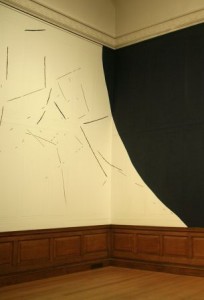
JR: There are a number of different spatial and temporal scales at work in this project. These space-times are both past and present, local and trans-European, real and imagined. Could you elaborate on what you believe to be the significance of these many spatio-temporal relationships?
AM: This is an enormous question but the answer that comes to my mind straight away consists of a single word: transgression. For me, the artistic ‘event’ emerges from between a number of different scales and time-frames that have been put together. Of course, there is the juxtaposition of the eighteenth century portraits of King Stanislaw and my linear intervention but, in drawing a conceptual bridge linking London and Warsaw I am also proposing an alternative cartography. The transgressive quality to this work lies in its crossing over from one state or time to another (and remember that the Poland I knew was one of tightly policed borders) but it is also present in the various explorations of in-betweenness. In painting, the real art is not in the brush-strokes but in the spaces between them. Similarly, the movements made by dancers animate the space that exists between their limbs.
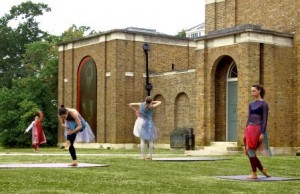
JR: Ian Dejardin, the gallery’s director, has spoken about the weight of history lying behind The Polish Connection. However, this needs to be off-set against the immediacy of your work and the importance to you of the project’s temporary status. How do you account for these different impulses?
AM: There is a two-way pull, in my work, between that which endures and that which is short-lived. I spend a lot more time looking at the old masters than I do at contemporary art. I learn so much more from these older works. The predominantly brown colour of the installation on the gallery’s exterior echoes the colour of many of the paintings inside. So, yes, there is historical awareness in my work. In my paintings and installations as well as in the performance events that I have initiated, I have been dealing with time and, especially, with the relationship between different tempi. I have often found that combinations of the fleeting and the very slow can create a productive tension. The Polish artist and theatre-maker Tadeusz Kantor believed that only the ephemeral was valuable. I would agree with that sentiment and that is why so much of my work has been intended only for its particular moment. A line is a trace of an ephemeral action: the action of drawing. There is an interesting relationship here between spatiality and temporality, between painting and dancing although, in dance, the ephemeral movement is the thing itself.
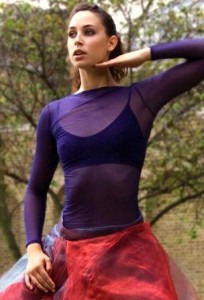
JR: The art historian Paul Hills refers to your technique for linear “notation” as “essentially musical” and he situates your work in a “chromatic space” of rhythm and harmony (exhibition catalogue, 2009: unnumbered). Sarah Kent notes your preference for “sculpting” with light (exhibition catalogue, 2009: unnumbered). Can you tell me a bit more about the use of processes drawn from, or traditionally associated with, other disciplines in your work?
AM: An inter-disciplinary perspective is the best way to distance oneself from one’s own discipline in order to see it more clearly. I use various methods to try to achieve this necessary distance. For instance, by using the metaphor ‘sculpting’ to describe the activity of painting, I imagine the action of sculpting the air and this helps me to mark the space with my lines in a manner that is very precise. I also draw on music and performance to supply me with metaphors. But, of course, painting (like music and dance) is also an art of time. Think of the theories of ancient Chinese painting in which a brush-stroke is understood as a notation of time. Time, the fourth dimension, is folded into two dimensions. Then again, there is an unfolding of time that occurs whenever we encounter a painting. The dance of time in a Watteau painting is something we can experience daily; his artistry lay in his ability to make it ever present.
JR: Your willingness to collaborate with various artist associates — notably, the choreographer Yong Min Cho — means that your projects form meeting points for multiple acts of translation: most importantly, from architecture into art and then into dance. How did the dance performances of 20-21 June and 27-28 June relate to your work here?
AM: Yong Min’s choreography was strictly linked to the forms established in the painting and the linear wall drawing but it was also derived from the architecture of the façade, cloisters and landscaped gardens. It used aspects of the arch shape, and of the elements within the arch (rectangle + semi-circular top, but also floating rhomboids, lines and edges) and also the vectors that I had traced inside the gallery, the edges of the Prussian blue ‘curtain’ and so on. Rolf Gehlhaar’s musical score played with the sound of selected words in English and Polish, and the rhythm of silences and tones that are present in my painting and drawing. Since the painterly intervention was site-specific, the dance performance, which was set on a diagonal line from the gallery across the lawn, took on this strong relationship to the geometry of the building and its grounds, effectively translating the 2D elements into a 4D experience.
JR: The patterns that were established between the solitary male dancer (Yong Min Cho) and three faster-moving female dancers (Carlotta Bruni, Georgina Cavendish and Karolina Kraczkowska) were a marked feature of the dance performance. In part, there was a feeling of estrangement between the single figure and the group but there was also a sharing of gestures, motifs and themes between them. What was the idea underlying the arrangement of parts?
AM: Resonance is the underlying theme of this whole project. The idea was to explore how a gesture, a whim might reverberate through time and space. The solitary figure moved very slowly indeed and the question of whether he was anticipating or repeating the quicker movements of the other dancers is one that must remain open.
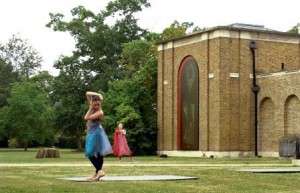
JR: One final question: above all, your architectural-scale work concerns the movement of light in and across buildings and the performance of colour as it is modulated by light, shadow and human activity. Is there a distinctive quality to London light and, if so, how did it affect the choices that you made at Dulwich?
AM: Let me answer that question in two parts because there is a pronounced difference between indoor and outdoor works. Firstly, the Prussian blue of the interior walls pays homage to the eighteenth century portraits in The Polish Connection. This pigment was discovered in the early part of that century and used extensively throughout the period. It revolutionised the painter’s pallet because, mixed with certain other colours, it produces a range of new colours, including several shades of grey that were previously impossible to make. Secondly, as far as the exterior painting is concerned, one has to see my work here as a large, light-sensitive installation. My painting for the blind niche had to complement the London brick of the gallery’s façade but I was also keen to capture the continually changing shades of London light. After conducting a series of colour tests, I found the right pigment and mixed the base colour for the painting. Over this, I applied layers of semi-translucent, highly reflective diachromatic pigment. The finished colour shifts hue from a reddish tone in full sun to a silver-green when the sky is overcast. The pale greenish pigment that I used for some of the forms within the arch is also highly reflective and it changes quite dramatically according to the weather. One might say that the London light paints the painting.
To Cite This Article:
Juliet Rufford, ‘2D/4D: Malinowski at Dulwich’. Literary London: Interdisciplinary Studies in the Representation of London, Volume 7 Number 2 (September 2009). Online at http://www.literarylondon.org/london-journal/september2009/rufford.html. Accessed on [date of access]
